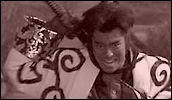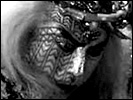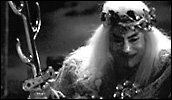Zipang
- Year
- 1992
- Original title
- Jipangu
- Japanese title
- ジパング
- Director
- Cast
- Running time
- 98 minutes
- Published
- 7 November 2002



by Tun Shwe
The Japanese call their homeland 'Nihon' or 'Nippon,' which translates as "origin of the sun." The most famous westerner to have travelled the Silk Road, Venetian voyager Marco Polo, called it 'Zipang' (or as the Japanese would pronounce it, 'Jipangu'). He was fascinated with Asia and in the employment of the Mongol ruler Kublai Khan he explored China. Although he never actually reached Japan, tall stories about it containing an infinite supply of gold were brought back to the West. His fabrications also included the existence of mythical creatures that served to protect the gold and prevent it from leaving the country. The film's title refers to the same mystical island that Marco Polo had spoken of, but assumes it lies in another dimension and that it indeed exists.
On film, Zipangu exists in a parallel universe. Sitting atop its land is a palace of gold that in turn sits atop a hill. Heavily guarded, within its doors lies a sizeable chunk of good wealth as measured by its weight in gold, literally. Needless to say that such a significant quantity of the world's richest element would attract the attention of possession-hungry moguls. Cue a king who, after reading about Zipang in Marco Polo's diary, wishes to find a way to access this legendary island and claim what he feels is rightfully his (i.e. all the gold articles in the universe). He sends out his right-hand agent of retrieval Hanzo, a brooding ninja of sorts accompanied by his army of stealthy brethren, who set out to retrieve a golden sword that acts as a vehicle for transportation to Zipang.
Meanwhile, in a different part of this alternate medieval land is Jigoku (Takashima), an ever-grinning swordsman who could be mistaken for an ape in human's clothing. Before the first 15 minutes of the movie are up you too will be convinced that there is no end to this man's talent for dispatching his opponents from their mortal coil. Zipang contains instantly memorable scenes featuring just about every stereotypical swordsman, bounty hunter, and samurai grunt you could hope for in a handful of Akira Kurosawa movies. Make the mistake of shifting your eyes off the screen for a minute and you might just miss the surreal references to Zatoichi or Cyrano de Bergerac, all of whom are out to get that hefty reward over Jigoku's head.
Being the centrepiece for his loyal entourage of friends-cum-fans, which include a diminutive comic whipping boy and the most jovial baby elephant you'll ever see, Jigoku completes the team of amateur treasure-hunters who are questing for the same magical golden sword as the King. Hot on Jigoku's tail are brother-sister duo of Yuri (Yasuda), an elegant but hard-as-nails bounty hunter, and Kikamaru. With her brother being fairly useless, Yuri has to heavily rely on her two-shooter pistol to get the job done, appropriately landing her the moniker 'Yuri the Pistol.'
From the moment of their destined meeting it becomes apparent that Jigoku's seemingly insurmountable admiration for his number one sword is surpassed only by his admiration for Yuri. He approaches his personal battles with little desperation, but when her life is on the line his enthusiasm shifts up several gears to the same intensity as that of a drowning man kicking for the surface. Shifting from one extreme to the next, for the duration of the movie the man is either a world-class barbarian or a giddy schoolgirl. A shame, really, that Yuri wants to kill him.
Through several instances of plundering, the sword is lost to the land of Zipang, taking Hanzo and Yuri with it. Helped by a native of Zipang called the Prophet (Ken), Jigoku traces the sword back to its homeland to make his rescue whereas the Prophet makes a long overdue return to free a Queen (Wanibuchi) incarcerated in a magical stone circle. She has been captured by the King of Zipang (Hira) who in a strange materialistic turn of fate has so much gold but yearns to find out what love is.
Asides from the science fiction in Zipang's characteristic, costumed universe, the one striking element that would hold the viewer's attention the whole way through is the variation in camera flourishes married with an affluent visual style. The costume design is a twist on true medieval Japanese urban streetwear and the locales sway between wide-open fields and claustrophobic subterranean passages. Takeo Kimura proves again that his artistry in immaculate set design and art direction has not diminished over his five decades in the profession, which also includes production design and writing credits for Seijun Suzuki's Tokyo Drifter (1966) and Branded To Kill (1967), respectively. With such a bombardment of cinematographic genius it would be fair to say that Kaizo Hayashi is a virtuoso of filmmaking.
Hayashi's first outing behind the camera was To Sleep So As To Dream (1986) but he didn't make an impact in the film industry until his second feature Circus Boys (1989), which was lauded by critics and picked up awards at various film festivals. His popularity as a contemporary filmmaker was chiselled in stone when The Most Terrible Time in My Life (1994) proved to be so successful that it spawned two sequels and eventually a TV series featuring its protagonist Mike Hama. Zipang itself was popular enough to inspire a venture into the video game market with a Playstation 2 release by Konami. With a plot based on its protagonists, the film manifested on the gaming platform as a cinematic 3D adventure slash/shoot-em-up under the guise of Seven Blades.
Just like the controversial Battle Royale (2000), Zipang contains a frequency of slaughtering to veil the deep messages embedded within its story. The difference between the two is startlingly clear after looking at the volumes of blood employed in their respective death sequences. Battle Royale spilt gallons of fake/CGI blood (especially by the time its Special Edition was released) but Zipang made a point of minimising on the gushing red symbolic in films such as the Lone Wolf and Cub series, which ironically might disappoint some viewers.
In short, the samurai genre is stretched out as a canvas for painting an imaginative and gimmicky romantic story spun from a similar yarn as the Midas Touch. At times I thought I knew what was going to happen next, but my expectations were inevitably dashed on the rocks of Zipang's brand of novel storytelling; a surprise I would liken to dipping one's toes into a snowy winter lake only to find the water warm. Underlying all its darkness and carnage is a beauty simple in meaning. By pulling away these top layers one is left with a visceral story about friendship and love, and how these are the two most important things one could ever hope to hold on to.